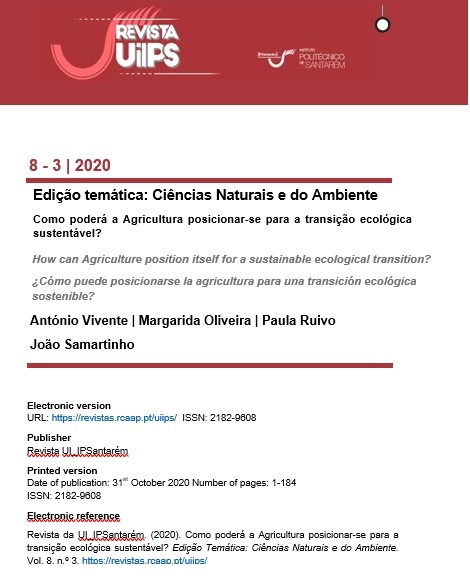INFLUÊNCIA DA APLICAÇÃO DE DIFERENTES DOSES DE AZOTO EM CEVADA DÍSTICA PARA MALTE
DOI:
https://doi.org/10.25746/ruiips.v8.i3.21326Palavras-chave:
Adubação azotada, componentes do rendimento, Hordeum vulgare L., produtividade, SPAD.Resumo
O azoto influência a produtividade e a proteína do grão de cevada dística para malte. Este trabalho teve como objetivo avaliar o efeito de doses de azoto na produtividade, proteína no grão e outros componentes do rendimento em cevada dística, cultivar “Pewter”. A experiência decorreu no Cartaxo, num delineamento experimental completamente casualizado, com quatro doses de azoto (N) [0 (N0), 100 (N100), 150 (N150) e 200 (N200) kg N ha-1], aplicado na forma nitroamonical, e quatro repetições. Os tratamentos influenciaram significativamente o afilhamento e a produção de matéria seca. O número de espigas por planta e unidade de área aumentou com a adubação azotada e o peso seco das espigas decresceu em N200. A produtividade seguiu um modelo quadrático, alcançando-se o valor máximo para N150. Os tratamentos não influenciaram significativamente o peso de mil grãos e o peso específico. Os valores de SPAD (Soil and Plant Analysis Development) foram inconclusivos. O teor de proteína bruta no grão foi inferior ao normalmente exigido pela indústria.
Downloads
Publicado
Versões
- 2021-06-24 (2)
- 2020-10-31 (1)
Como Citar
Edição
Secção
Licença
Direitos de Autor (c) 2020 Revista da UI_IPSantarém - Unidade de Investigação do Instituto Politécnico de Santarém

Este trabalho encontra-se publicado com a Licença Internacional Creative Commons Atribuição-NãoComercial-SemDerivações 4.0.
Autores que publicam nesta revista concordam com os seguintes termos:
- Autores conservam os direitos de autor e concedem à revista o direito de primeira publicação, com o artigo simultaneamente licenciado sob a Licença Creative Commons Attribution que permite a partilha do trabalho com reconhecimento da autoria e publicação inicial nesta revista.
- Autores têm autorização para assumir contratos adicionais separadamente, para distribuição não-exclusiva da versão do artigo publicado nesta revista (ex.: publicar em repositório institucional ou como capítulo de livro), com reconhecimento de autoria e publicação inicial nesta revista.
- Autores têm permissão e são estimulados a publicar e distribuir o seu trabalho online (ex.: em repositórios institucionais ou na sua página pessoal) a qualquer ponto antes ou durante o processo editorial, já que isso pode gerar alterações produtivas, bem como aumentar o impacto e a citação do trabalho publicado.



